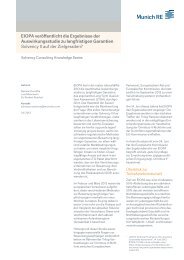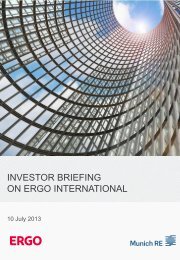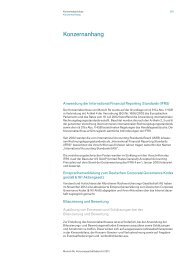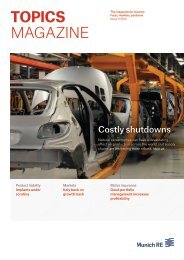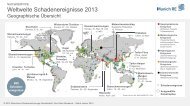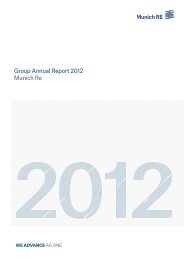Munich Re Group Annual Report 2006 (PDF, 1.8
Munich Re Group Annual Report 2006 (PDF, 1.8
Munich Re Group Annual Report 2006 (PDF, 1.8
You also want an ePaper? Increase the reach of your titles
YUMPU automatically turns print PDFs into web optimized ePapers that Google loves.
<strong>Munich</strong> <strong>Re</strong> <strong>Group</strong> <strong>Annual</strong> <strong>Re</strong>port <strong>2006</strong><br />
liabilities, which are described on page 210 of the notes to<br />
the financial statements. Off-balance-sheet financing does<br />
not play a significant role in the <strong>Munich</strong> <strong>Re</strong> <strong>Group</strong>.<br />
Asset-liability management<br />
The structure of our technical provisions and other liabilities<br />
is the basis for the <strong>Munich</strong> <strong>Re</strong> <strong>Group</strong>’s investment<br />
strategy. The main focus of this strategy is asset-liability<br />
management, the aim of which is to ensure that economic<br />
factors influence the value of our investments and the<br />
value of our technical provisions and liabilities in the same<br />
way, thus cushioning the effect of capital market fluctuations.<br />
For this purpose, we mirror important features of<br />
the liabilities, such as maturity patterns, currency structures<br />
and inflation sensitivities, on the assets side of the<br />
balance sheet by means of investments with similar characteristics.<br />
If, for instance, there is a strong rise in inflation,<br />
our nominal outflows as a result of claims payments increase<br />
significantly. This applies in particular to lines of<br />
business with long payout patterns, e.g. liability, as inflation<br />
accumulates over a number of periods. To an increasing<br />
extent we are endeavouring in our asset-liability management<br />
to structure our investment portfolio in such a<br />
way that inflows from investments increase in line with<br />
rising inflation rates. To configure our asset-liability management<br />
as effectively as possible, we also use derivative<br />
financial instruments, which are described on page 171<br />
of the notes to the financial statements.<br />
Capital management<br />
Through active capital management, we ensure that the<br />
capital of the <strong>Munich</strong> <strong>Re</strong> <strong>Group</strong> is always maintained at<br />
an appropriate level. The <strong>Group</strong>’s available capital must<br />
always be sufficient to cover the capital requirements<br />
determined both by our own internal risk model and by the<br />
requirements of supervisory authorities and rating agencies.<br />
In this way, we ensure that our financial strength is<br />
sufficient for us to take advantage of measured opportunities<br />
for growth, while remaining at a reasonable level even<br />
in the wake of major loss events or substantial falls in the<br />
stock markets. At the same time, we also define an appropriate<br />
level of <strong>Group</strong> capital as one which does not significantly<br />
exceed that required for our operations. A lean cap-<br />
98<br />
Management report_Financial situation<br />
ital level makes a decisive contribution to financial discipline<br />
in all our business processes. Our active capital management<br />
includes returning surplus capital to equity holders<br />
through attractive dividends and share buy-backs. Our<br />
proposed dividend is linked directly to the <strong>Group</strong> result, of<br />
which we aim to pay out a minimum of 25%. We also make<br />
use of share buy-backs as a flexible way of returning capital<br />
to our shareholders. Naturally, we liaise closely with<br />
the regulators, rating agencies and capital market participants<br />
in this regard.<br />
Essentially, we see efficient and transparent capital<br />
management as an appropriate means of achieving our<br />
goal of being recognised as a reliable partner in the capital<br />
markets. This should guarantee our ability to raise capital<br />
quickly and easily on the capital markets, especially for<br />
large potential growth opportunities.<br />
In addition to the level of capital, its efficient deployment<br />
is also a key factor. We use our value-based management<br />
(see page 52f.) to set performance targets designed<br />
to ensure that every investment achieves a sustainable<br />
return commensurate with the risk involved. To limit fluctuations<br />
in results owing to major losses, we have also<br />
developed guidelines and limit systems within the framework<br />
of integrated risk management and corporate underwriting<br />
for our reinsurance companies. We protect the<br />
results and capital of our primary insurance companies<br />
against unacceptable fluctuations by means of suitable<br />
reinsurance covers.<br />
Our internal risk model, which we use to analyse how<br />
certain risk scenarios affect segment results and investments,<br />
plays a central role in capital management. We<br />
determine our economic capital on the basis of the internal<br />
risk model data so that we are able to absorb two successive<br />
annual losses of a size expected only every 100 years.<br />
Next, the determined capital is allocated proportionately to<br />
divisional units in line with the volatility of their business<br />
activities. Our procedure in the primary insurance group<br />
also takes account of management factors arising mainly<br />
out of supervisory restrictions and clients’ participation in<br />
surpluses. We continuously review the assumptions on<br />
which the internal risk model is based and adjust them as<br />
required.



